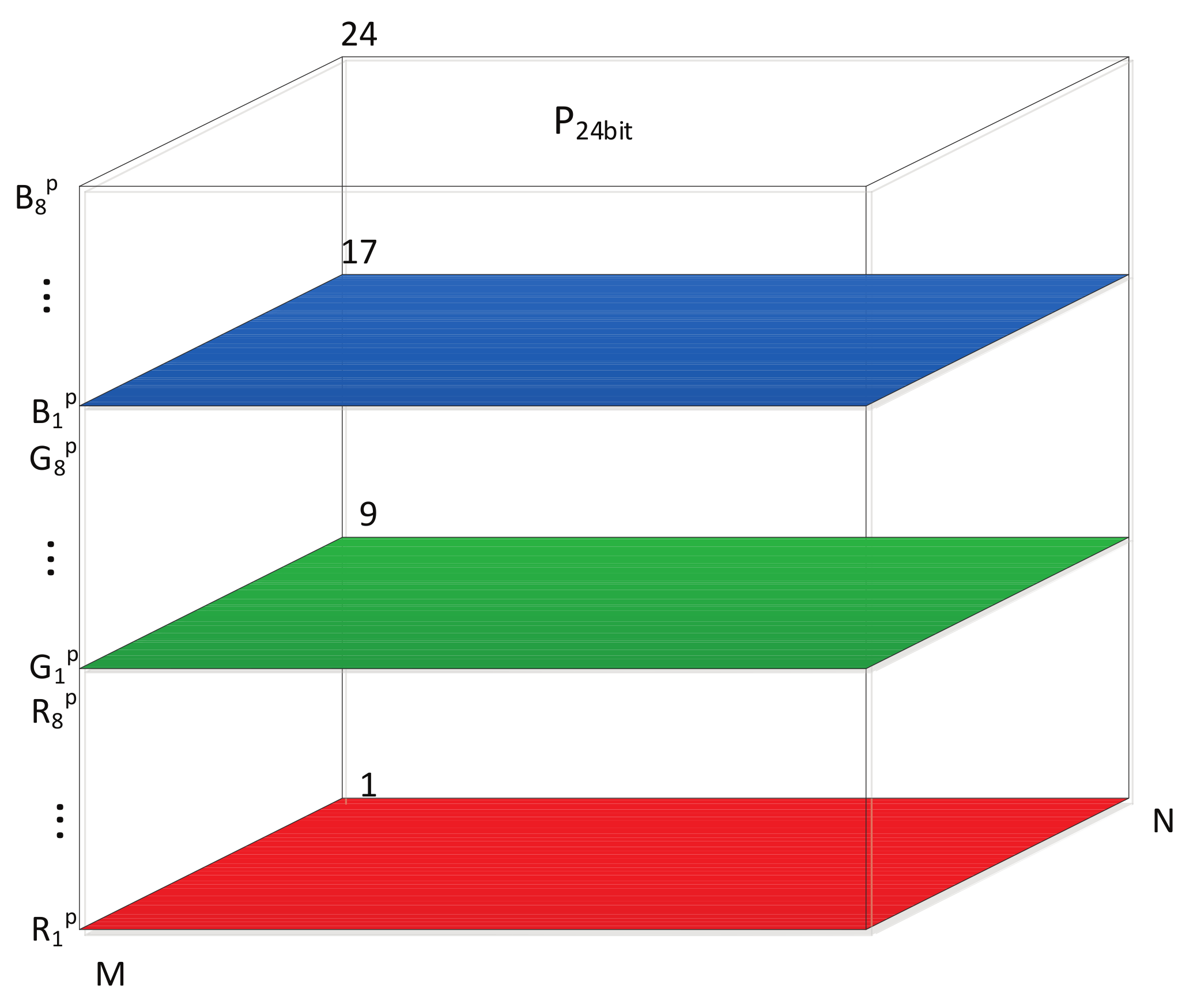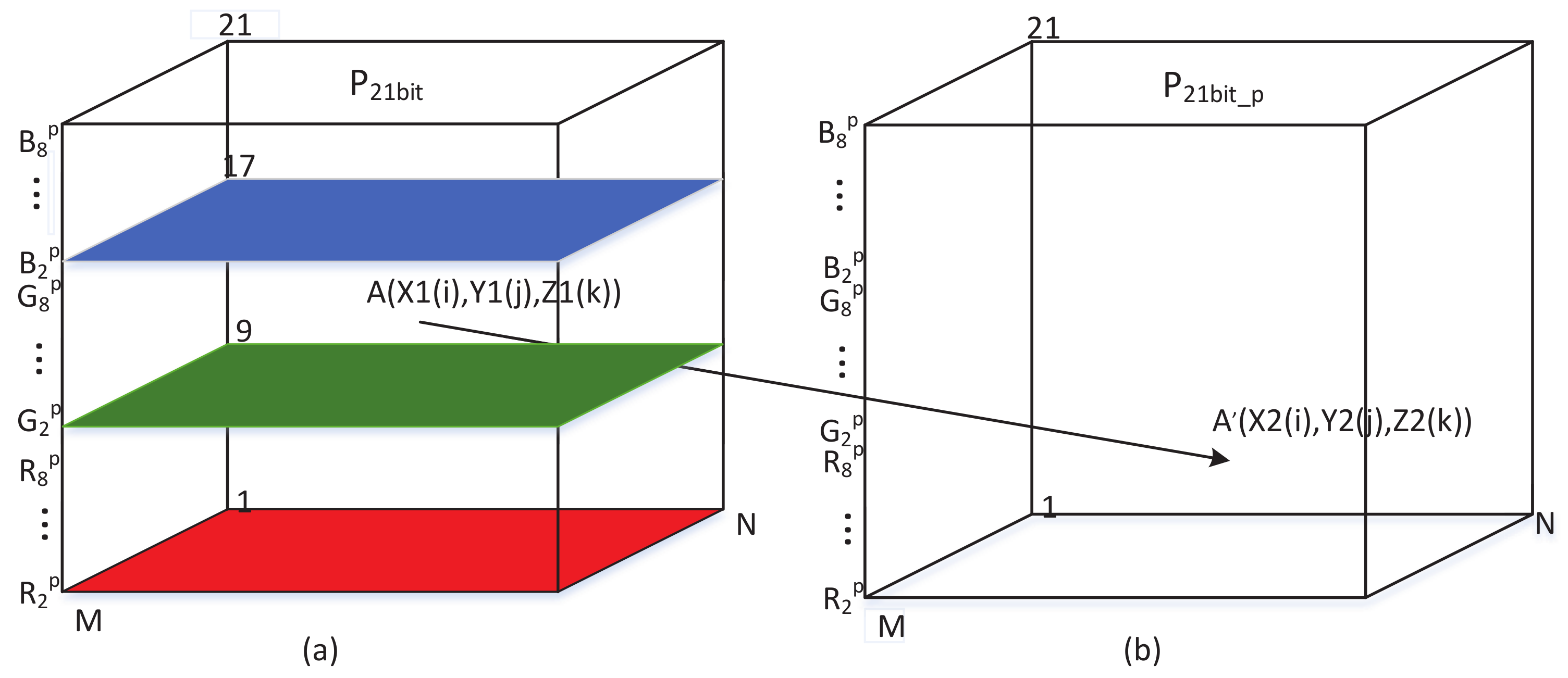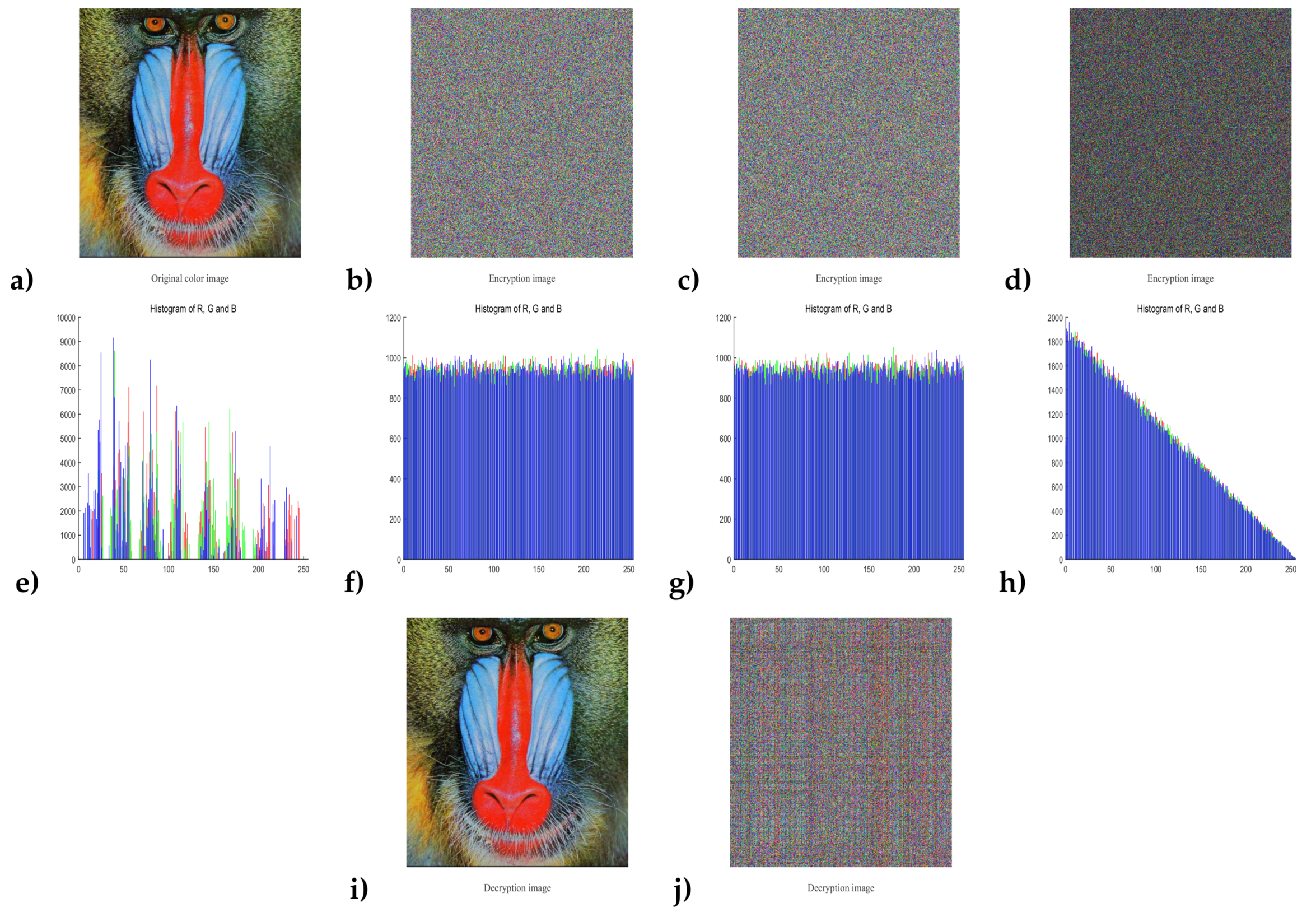1. Introduction
With the dramatic development of Internet technology, a great deal of sensitive information conveyed by digital images has been transmitted over public networks. The security problems of image transmission have become increasingly serious, especially for those related to confidential, medical, military, or commercial affairs. However, since digital images have some inherent characteristics (e.g., high redundancy, large data capacity, and strong correlation between adjacent pixels), the traditional block ciphers like Data Encryption Standard (DES), International Data Encryption Algorithm (IDEA), Advanced Encryption Standard (AES), RSA (Rivest–Shamir–Adleman), etc. do not have high performance. In recent years, chaotic maps have been used in image encryption, which have benefited from their excellent properties, such as strong ergodicity as well as sensitivity to initial conditions and control parameters. As early as 1989, Matthew suggested the use of logistic maps to generate pseudo-random numbers, which can be used to encrypt messages [
1]. In 1998, a new symmetric block encryption scheme proposed by Fridrich [
2] drew a great deal of attention. The architecture is similar to the one Shannon introduced in [
3], which includes a pixel-level permutation-diffusion structure. In the permutation stage, the pixel position is scrambled to disturb the strong correlation between two adjacent pixels of the original image, but the pixel’s statistical property is not changed. Later, in the diffusion stage, the pixel values are modified to achieve a uniform distribution of pixel values [
4,
5,
6,
7,
8,
9]. For instance, Gao et al. used a total shuffling matrix to change the image pixel positions in the permutation stage, and then a hyper-chaotic system is used to modify the pixel values of the shuffled-image to obtain the cipher-image [
4]. In [
5], four values obtained from the logistic map are used to disorder four equal sub-images divided from the plain-image, and then a total shuffling matrix is used to shuffle the position of the pixels in the whole plain-image. Finally, the four sub-images are diffused simultaneously in parallel. More recently, chaotic systems have been used to encrypt images in specific fields. For example, Abundiz-Pérez et al. proposed a high-security and fast fingerprint image encryption scheme based on hyperchaotic Rössler maps [
6]. In [
8], a novel symmetric encryption algorithm based on confusion-diffusion architecture is provided and used to encrypt clinical information. All simulation results of the encryption system show its effectiveness, security, and robustness. Compared with gray-level images, color images can provide more information, so color image encryption attracts increasing attention. In recent years, plenty of chaos-based color image encryption algorithms have been proposed [
10,
11,
12,
13,
14,
15,
16,
17]. In order to make the RGB components of a color image affect each other and obtain high security, Wang et al. [
10] used a chaotic system to encrypt these three components at the same time. In [
12], Wang et al. transformed the R, G, and B components of a color plain-image into a matrix. When the matrix is passed through a permutation operation using zigzag path scrambling and a substitution process, the ciphered color image is obtained. Later, in 2017, Huang et al. [
15] used Logistic map to diffuse the color image, then the RGB components are scrambled by Logistic mapping. Secondly, double random-phase encoding is used to encrypt the three scrambled sub-images into one encrypted image.
A bit-level permutation (BLP)-based cryptosystem has been proposed as a new image encryption algorithm [
18,
19,
20,
21,
22,
23,
24,
25,
26]. BLP considers images as 3D bit matrices (width, height, and bit-length). So, the basic operation unit in the permutation stage is performed on bits rather than pixels. As the bits in different bit-planes of an image contribute different effects to visualization, Xiang et al. [
18] proposed an image encryption scheme in which only the higher four bits of each pixel are encrypted and the lower four bits are unchanged. Compared with pixel-level permutation, bit-level permutation not only changes the position of the pixel, but also modifies its value. Although several rounds of 2D scrambling on each bit-plane of a plain-image are performed in some bit-level-based image encryption algorithms, the statistical property of each scrambled bit-plane are not changed. However, by combining these scrambled bit-planes to produce encrypted pictures, the statistical property of pixels in the encrypted image will be changed. For example, Zhu et al. permuted the higher four bit-planes independently and permuted the four lower bit-planes together with the Arnold cat map in [
19]. Due to the problem that the permutation using 2D chaotic maps has a repeated pattern and there are strong correlations among the adjacent bit-planes (especially between higher bit-planes like the seventh and the eighth bit-planes) [
21], the BLP algorithm should allow one bit in any plane to be moved to any other position in any plane. Recently, various schemes with improved properties have been proposed [
22,
23,
24,
25,
26]. In [
23], a symmetric chaos-based image cipher with a spatial bit-level permutation strategy is proposed. Compared with the recently proposed bit-level permutation methods, the confusion and diffusion effect of this new method is superior, as the bits are shuffled among different bit-planes rather than within the same bit-plane. Zhang et al. [
26] proposed a new 3D bit matrix permutation mechanism which can access the bits of the plain-image randomly rather than in an orderly fashion. Furthermore, for color image encryption, bit-level permutation-based encryption algorithms have the advantages that they can achieve the interaction between RGB components in the scrambling phase, which can improve the security of encryption.
However, for most chaotic-based image encryption schemes, the relationship between permutation stage, diffusion stage, and the plaintext image is independent. Such algorithms have the following security flaws: (1) the architecture is insensitive to the original image; (2) the statistical property of the original image can be observed once the diffusion key or diffusion sequence is cracked; (3) the algorithm cannot resist chosen-plaintext and chosen-ciphertext attack. As shown in
Table 1, most of the permutation-diffusion structure-based cryptosystems [
27,
28,
29,
30,
31,
32,
33] are attacked by chosen-plaintext attack and chosen-ciphertext attack.
More recently, in order to resist the powerful chosen-plaintext and chosen-ciphertext attacks, a plaintext related image encryption scheme was proposed [
12,
23,
34,
35,
36,
37,
38,
39,
40,
41]. For some algorithms, the previous encrypted pixel is used to encrypt the current pixel, and after several rounds of processing in the diffusion stage of some algorithms, so the information of one pixel in the plain-image can be spread into the entire cipher image [
23,
35,
36]. In some other image encryption systems [
12,
23,
35,
36,
37,
38,
39], the key streams for encryption are related to the plain images. For instance, in [
38], the initial state conditions of chaotic maps are extremely dependent on plain image, so the generated key streams are highly sensitive to the original pictures to resist known/chosen plaintext attacks. In [
39], Liu et al. presented a fast image encryption algorithm. In the scheme, the iteration values of 2D-SIMM are influenced by the encrypted pixel value, and the step size of cyclic shift and the secret key for substitution will be different with different images. Therefore, the designed algorithm can resist known-plaintext and chosen-plaintext attacks. A chaos-based color image encryption algorithm was proposed in [
41], in which the color image is converted into three bit-level images and combined to one bit-level image. Then, only permutation operation is performed to encrypt the integrated bit-level image to reduce the execution time. Some of the plaintext-related algorithms mentioned above present low space keys, high encryption time, or insufficient security to resist powerful known/chosen plaintext attack. For instance, the encryption algorithm presented in [
34] was cryptanalyzed and broken with chosen-plaintext attack in [
42].
Based on the analysis above, this paper presents a new symmetric color image encryption system based on a plaintext-related random access bit-permutation mechanism (PRRABPM). Our encryption system has the following features:
- (1)
For color image encryption, bit-level permutation-based encryption algorithms have the advantages that they can achieve the interaction between RGB components in the scrambling phase, which can improve the security of encryption. So, this paper proposes a new random access bit-permutation mechanism in the permutation stage, which can obtain a good permutation effect and mask the statistical properties of the original image even though the diffusion key or diffusion sequence is cracked.
- (2)
In order to obtain high plain sensitivity and key sensitivity, the key streams used in random access bit-permutation mechanism operation are extremely dependent on plain image in an ingenious way. Therefore, the encryption system is sensitive to tiny differences in key and original images, which means that it can efficiently resist chosen-plaintext and chosen-ciphertext attacks.
- (3)
Not only color images but also gray images of any size can be encrypted by our encryption scheme.
- (4)
For the excellent performance of PRRABPM used in the permutation stage, the permutation-diffusion operation in our encryption scheme is performed only once.
The structure of this paper is as follows.
Section 2 briefly reviews the chaotic maps used in this dissertation: tent map, Chebyshev map, and piecewise linear map.
Section 3 proposes a plaintext-related random access bit permutation mechanism (PRRABPM). In
Section 4, we evaluate the performance of the new algorithm and show the results of simulation and analysis. The last section gives a conclusion.
5. Conclusions
In contrast with the similar studies, a plaintext-related random access bit-permutation mechanism (PRRABPM) is presented in this paper. This method is used in the permutation stage to shuffle the RGB components of a color image at the same time, making these three components interact with each other. Furthermore, the key streams used in random access bit-permutation mechanism operation is extremely dependent on plain image in an ingenious way, which makes the encryption system sensitive to key and original images. Thus, the proposed encryption system can efficiently resist the chosen-plaintext and chosen-ciphertext attacks. Experimental results analysis including key space, histogram, correlation, sensitivity, information entropy, and speed are also given, showing that the proposed algorithm has a good security performance.
The proposed method may be used for image security communication applications. According to simulation results, the proposed algorithm is not suitable for real-time applications. Now, our main concern is the strength of the encryption algorithm and its ability to work with the limitations of security communication systems, which require further study. In our future work, we will consider this part in detail and improve the encryption speed. It may also be considered to integrate the image encryption with an image compression algorithm so as to enhance security for image transmission over communication systems.













